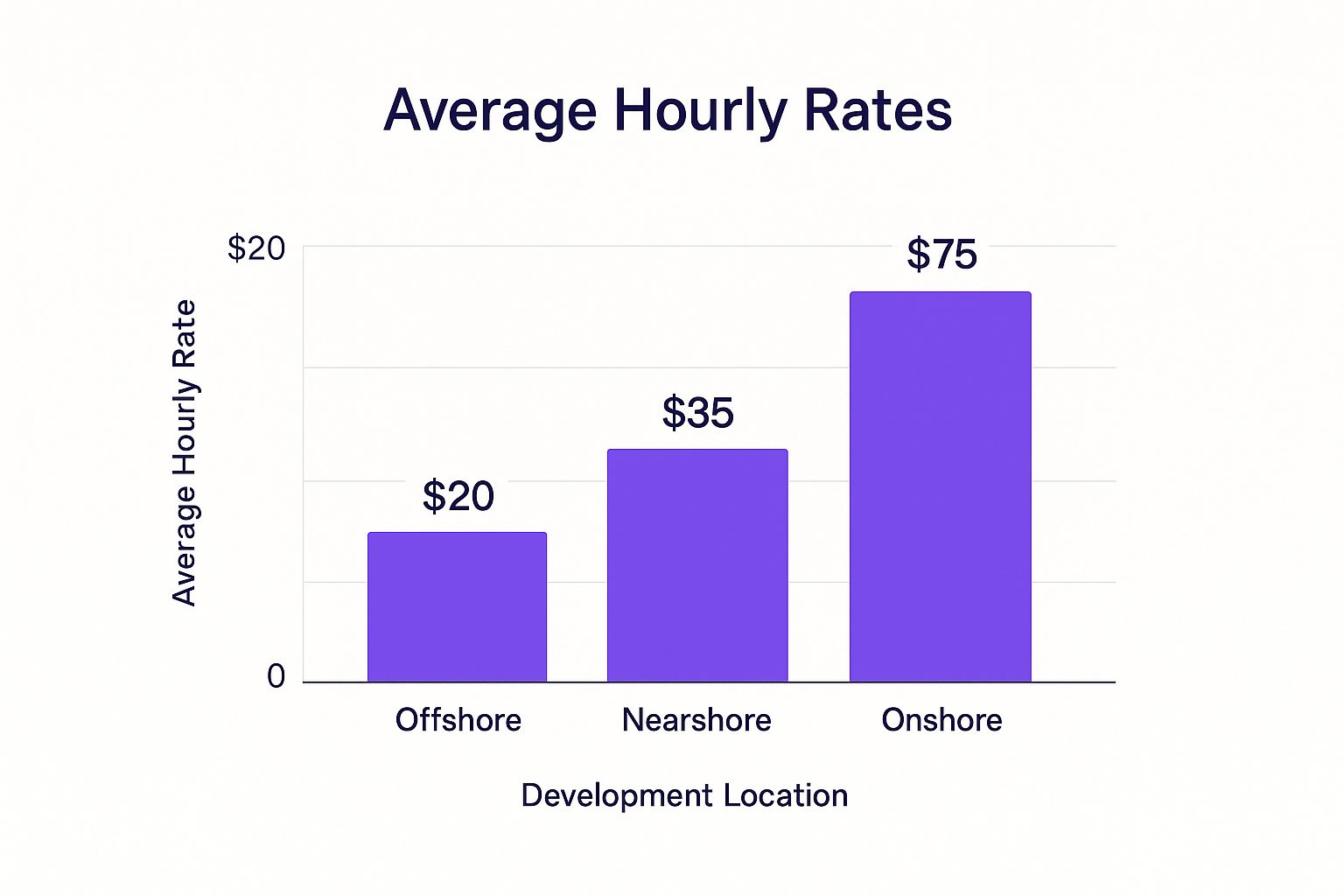Andres M. · Updates · May 21, 2025
Offshore vs Nearshore - Find Your Perfect Outsourcing Fit

Both offshore and nearshore outsourcing provide access to talent outside your company. However, their geographical differences create distinct operational approaches and advantages. Offshore outsourcing usually involves partnering with companies located far away, often across multiple time zones. It’s similar to buying a product online from another continent: potential cost savings might come with longer delivery times and communication hurdles.
Location and Time Zone Differences
Nearshore outsourcing, in contrast, focuses on nearby countries or regions. This proximity leads to closer cultural alignment, smaller time differences, and easier travel for in-person meetings. Think of it as buying something from a neighboring town; you can easily pick it up yourself and quickly address any concerns. These factors significantly impact collaboration, project management, and communication. For example, a US company might choose nearshore partners in Latin America for simpler collaboration during regular business hours. This can minimize delays and communication issues.
Communication and Collaboration
Geographical closeness promotes better communication, quicker responses, and more efficient problem-solving. Cultural similarities in nearshore setups can also reduce misunderstandings and build stronger team relationships. However, it’s worth noting that cultural differences exist even within nearshore regions. Understanding these nuances is key for successful partnerships. Therefore, carefully considering cultural compatibility is vital, even with nearshore teams.
Cost Considerations and Talent Pools
Offshore outsourcing often offers lower labor costs, a major draw for many businesses. However, this must be weighed against potential communication challenges and increased management overhead. Nearshore options, while possibly more expensive than offshore, often improve communication efficiency and reduce logistical hurdles. These factors can result in faster turnaround times and better quality results, ultimately benefiting a company’s bottom line. The balance between cost and effectiveness is a crucial consideration when deciding between offshore and nearshore outsourcing. In 2025, the global offshore outsourcing market is predicted to be worth over $300 billion annually. This demonstrates the increasing need for specialized skills. The market reflects a shift beyond basic tasks towards specialized expertise in areas like IT, data analytics, and AI development. For more in-depth statistics, see: Learn more about offshore outsourcing trends.
The Real Economics: Breaking Down Offshore vs Nearshore Costs

The infographic above illustrates average hourly rates for offshore, nearshore, and onshore developers. The initial hourly rate for offshore talent is noticeably lower. However, focusing only on these initial numbers can be deceptive. A true cost assessment requires a broader perspective, considering the overall project budget and potential hidden costs.
While offshore outsourcing might appear cheaper upfront, unforeseen factors can significantly inflate the total investment. Communication inefficiencies and increased project management overhead are common examples. Think about extra time spent clarifying requirements, resolving misunderstandings, or managing delays due to time zone differences.
These hidden costs can quickly diminish any initial savings from lower hourly rates. Travel expenses for in-person meetings or training should also be factored in. While offshore outsourcing generally offers lower labor costs, nearshore options often provide better communication and fewer logistical hurdles. This makes them an attractive choice for projects demanding frequent interaction and agility. Recent data shows how offshore rates for specialized roles are generally lower than nearshore rates. This reflects the premium placed on proximity and cultural alignment. Learn more about offshore vs nearshore cost considerations.
Hidden Costs and Long-Term Value
Nearshore outsourcing, despite sometimes having a higher hourly rate, can offer significant long-term value. Enhanced communication and collaboration can result in faster turnaround times, fewer errors, and a smoother project lifecycle. This efficiency translates into tangible cost savings.
For instance, a nearshore team might finish a project faster than an offshore team, even with a higher hourly rate, ultimately lowering the overall cost. This highlights the importance of a comprehensive cost evaluation that looks beyond just the hourly rate.
To illustrate the potential cost differences, let’s examine a comparison table:
Offshore vs Nearshore Cost Comparison
This table compares typical costs and financial considerations between offshore and nearshore outsourcing models across different factors.
| Cost Factor | Offshore Model | Nearshore Model | Business Impact |
|---|---|---|---|
| Hourly Rate | Lower | Higher | Initial cost difference |
| Communication | Can be challenging due to time zones and cultural differences | Easier due to proximity and cultural similarities | Impacts project efficiency and speed |
| Project Management | Higher overhead due to increased coordination needs | Lower overhead due to streamlined communication | Affects overall project cost |
| Travel Costs | Potentially higher for on-site visits | Potentially lower due to closer proximity | Influences total budget |
| Quality Control | Can be more complex due to communication barriers | Easier to manage with clearer communication | Impacts product quality and time to market |
As the table demonstrates, while offshore models might offer lower initial hourly rates, nearshore models often present advantages in communication, project management, and travel costs. These factors can significantly influence the overall project budget and timeline.
Calculating the True Cost
Accurately predicting project costs demands a thorough approach. Consider factors like project complexity, communication frequency, team size, and project duration. Building a house provides a useful analogy. While material costs are crucial, labor, permits, and unforeseen repairs also greatly affect the final budget.
Similarly, in outsourcing, evaluating the full project lifecycle is essential. You might be interested in: How to find AI-enabled developers.
Time Zone Alignment and Productivity
Time zone differences with offshore teams can hinder productivity. While asynchronous communication works for some tasks, real-time collaboration is vital for others. Nearshore teams, often in closer time zones, facilitate real-time interaction, enabling quicker problem-solving and decision-making.
This seamless communication saves time and improves project efficiency. This, in turn, contributes to cost savings, especially for projects with tight deadlines or complex needs. Considering these nuances is key when making outsourcing decisions.
Time Zones and Team Dynamics: The Human Element

Building on the cost analysis discussed previously, let’s explore the human side of outsourcing: time zones and team dynamics. Successfully managing a distributed team requires more than technical expertise. It requires understanding how time zones and cultural differences affect collaboration, communication, and ultimately, project success.
The Impact of Time Zone Alignment
Time zone differences can significantly impact daily work. An eight-hour difference, for example, can limit real-time communication, potentially slowing down decision-making and problem-solving. This makes quickly addressing urgent issues or having impromptu brainstorming sessions more challenging. However, this challenge also presents a unique opportunity.
Nearshore outsourcing, with its minimal time zone variations, often provides a practical solution. For businesses in the United States, nearshore outsourcing offers advantages like similar time zones. This facilitates smoother collaboration and quicker turnaround times compared to offshore options. The nearshore model’s popularity is increasing as businesses seek to mitigate the risks, such as time zone differences and language barriers, commonly associated with offshore outsourcing. Learn more about the differences between nearshore and offshore outsourcing.
Bridging Cultural Gaps
While similar time zones improve real-time communication, cultural understanding is essential for effective teamwork. Different cultures have different communication styles, feedback mechanisms, and problem-solving approaches. This can lead to misunderstandings if not addressed proactively.
Cultural differences can also influence team dynamics and working relationships. A lack of cultural sensitivity can damage trust and hinder effective collaboration, impacting project morale and outcomes. Direct feedback, for instance, might be standard practice in some cultures but seen as impolite in others. You can learn more about company culture in our articles.
Asynchronous vs. Synchronous Communication
Choosing between asynchronous and synchronous communication depends on the project. Tasks like coding or design often suit asynchronous workflows where team members work independently and provide updates periodically. Other tasks, like brainstorming or troubleshooting, benefit from real-time interaction through synchronous communication tools.
Nearshore teams, with closer time zones, often offer more flexibility to switch between both communication modes. This adaptability is vital for projects needing both independent work and frequent collaboration.
Building Trust and Psychological Safety
Creating trust and psychological safety within the team is crucial, regardless of the outsourcing model. This means creating an environment where everyone feels comfortable sharing ideas, voicing concerns, and taking calculated risks without fear of judgment.
This sense of security empowers team members to perform their best and encourages open communication. This, in turn, leads to improved problem-solving, increased innovation, and stronger team cohesion. The success of any outsourcing partnership depends on building authentic relationships and a shared purpose, even across geographical distances.
Talent Realities: Finding Expertise That Actually Delivers
After discussing time zones and team dynamics, the next critical factor in choosing between offshore and nearshore outsourcing is talent. Marketing materials are one thing, but the actual talent pool in your chosen location is another. This involves understanding the local educational systems, the tech community, and how professionals develop their skills.
Assessing Real Expertise
Distinguishing genuine expertise from inflated resumes requires careful evaluation. Think of it like hiring a contractor: you wouldn’t just rely on their website. You’d seek references and review past projects. Similarly, when evaluating outsourcing talent, practical skills and experience outweigh impressive titles. Experienced outsourcing managers emphasize the importance of thorough skills assessments and practical tests.
For instance, coding challenges or portfolio reviews can reveal a candidate’s true capabilities. Also, consider the local tech scene. A thriving tech community encourages ongoing learning and skill development, leading to a stronger talent pool. You might be interested in: Nearshore software development trends for 2020.
Regional Talent Strengths
Different regions often specialize in particular technical areas. Some may excel in mobile development, while others focus on AI or data science. Understanding these regional strengths can help you target specific locations. For example, if you need expertise in a specific programming language, research regions known for producing developers proficient in that language.
Furthermore, cultural alignment is crucial during talent evaluation. Technical skills are essential, but a candidate’s ability to integrate into your team’s culture and communication style is equally vital. Cultural fit promotes better collaboration and a more cohesive team.
The Untapped Middle Tier
While senior-level talent often gets the most attention, mid-level professionals can offer exceptional value. They possess solid skills and experience, often at a lower cost than senior developers. This middle tier represents a valuable resource for project success.
This often overlooked group combines practical experience with a desire to learn, making them a valuable asset. Identifying and nurturing this talent pool can provide a competitive advantage.
Talent Retention and Knowledge Continuity
Talent retention rates differ between offshore and nearshore models. High employee turnover disrupts project continuity and leads to knowledge loss. Nearshore models, often characterized by stronger employee engagement and better working conditions, can lead to higher retention rates.
This stability ensures valuable knowledge remains within the team, reducing the need for constant retraining. This is particularly important for long-term projects where knowledge continuity is essential. Choosing the right model involves considering the long-term implications for your outsourcing strategy.
Navigating Risk: When Location Really Matters

Following our discussion of talent acquisition, it’s important to address another key aspect of the offshore vs. nearshore decision: risk management. Outsourcing, while offering many benefits, also introduces potential risks. These risks extend beyond simple cost calculations and delve into critical areas like security, legal compliance, and business continuity.
Data Security and Intellectual Property
Protecting sensitive data and intellectual property is paramount. Where your data resides and how it’s managed are key considerations. Offshore outsourcing can introduce complexities regarding data governance, especially when dealing with countries that have varying data protection laws. Nearshore locations, often with more aligned regulations, can simplify compliance and reduce these legal risks.
For example, a nearshore partner in a region with similar data protection laws to your own can streamline compliance. This proactive approach protects your business from potential legal headaches and safeguards your valuable data.
Business Continuity and Crisis Response
Unforeseen events, from natural disasters to political instability, can significantly disrupt operations. Consider how geopolitical factors and regional stability might affect your chosen outsourcing location. Nearshore partnerships, due to geographical proximity, often allow for quicker responses and easier on-the-ground support during a crisis.
Also, consider infrastructure reliability. Power outages or internet disruptions can severely impact productivity. Evaluating the infrastructure in your chosen outsourcing location is essential for maintaining business continuity.
Legal and Regulatory Compliance
Different countries have different legal and regulatory environments. This is important for intellectual property protection and contract enforcement. Nearshore locations often offer more legal certainty and stronger intellectual property protections, minimizing potential risks.
Nearshore outsourcing is becoming increasingly popular due to aligned time zones and cultural similarities, leading to improved project management and fewer delays. Offshore outsourcing remains cost-effective, but challenges like 12+ hour time differences can complicate collaboration. This has led to hybrid models combining nearshore and offshore resources to balance cost and operational needs. Learn more about outsourcing statistics: Find more detailed statistics here.
Mitigating Risks Through Due Diligence
Effective risk mitigation requires thorough due diligence. This includes carefully vetting potential partners, establishing clear contracts, and implementing robust operational protocols. This also means evaluating the partner’s security measures, data handling practices, and their own business continuity plans.
Establishing clear communication channels and escalation procedures is also crucial. Regular audits and performance reviews ensure your partner consistently meets your security and compliance standards. This ongoing monitoring minimizes potential risks and maintains a high level of security.
Frameworks for Risk Assessment
Developing a structured risk assessment framework is essential. This framework should evaluate regional stability, infrastructure reliability, legal enforceability, and the partner’s security protocols. This structured approach enables informed decisions aligned with your company’s risk tolerance and compliance requirements.
Consider factors like political stability, economic conditions, and the potential impact of natural disasters when assessing regional risks. Evaluate the reliability of the local infrastructure, including internet connectivity and power supply. This proactive approach empowers businesses to make informed decisions and manage potential risks effectively.
Best of Both Worlds: Creating Hybrid Outsourcing Models
While offshore outsourcing offers significant cost advantages, and nearshore outsourcing provides closer proximity and cultural alignment, a hybrid model often provides the most effective solution. This approach strategically combines the strengths of both models, maximizing benefits and minimizing risks. Think of it as diversifying an investment portfolio: spreading resources across different areas reduces risk and improves the chance of higher returns.
Strategically Distributing Functions
A hybrid approach empowers businesses to allocate specific functions to the most suitable location. Tasks requiring frequent communication and rapid turnaround times, for example, might be best suited for a nearshore team. More routine tasks, or those requiring specialized skills less readily available nearshore, could be assigned to an offshore team.
Imagine a software development project. The core development team, which requires constant communication, could be nearshore. Specialized QA testing or specific code modules might be handled by an offshore team to leverage cost advantages.
Team Integration and Communication Protocols
Effective integration and communication are crucial for success in a hybrid model. Establishing clear communication channels, regular meetings, and shared project management tools is essential. For instance, daily stand-up meetings using video conferencing software can keep everyone aligned, even across different locations.
Additionally, consider the cultural differences between teams. Promote open communication and cultural sensitivity training to bridge any potential gaps and foster a collaborative environment where diverse teams can thrive.
Implementing Governance Frameworks
Maintaining control without stifling innovation requires well-defined governance frameworks. Establish clear roles, responsibilities, and reporting structures across both nearshore and offshore teams. Regular progress reports and performance metrics help track project status and ensure accountability.
This structure provides oversight and control without micromanagement, empowering teams to work efficiently while adhering to project requirements. This balance fosters innovation and allows teams to perform at their best.
Creating a Unified Team Culture
Even with geographically dispersed teams, a unified team culture is critical. Encourage team-building activities, virtual social events, and cross-cultural training to foster a sense of community and shared purpose. This creates a more cohesive and productive working environment.
Regular online social gatherings or team-building exercises, for example, can strengthen relationships and build camaraderie, regardless of location. This helps bridge geographical gaps and creates a shared sense of belonging.
To illustrate how various business functions can be optimally distributed, let’s examine the following table:
Hybrid Outsourcing Model Comparison
This table illustrates how different business functions can be optimally distributed across offshore and nearshore locations in a hybrid model.
| Business Function | Recommended Model | Key Considerations | Expected Benefits |
|---|---|---|---|
| Software Development (core team) | Nearshore | Requires frequent communication and quick turnaround times | Faster development cycles, improved collaboration |
| Specialized QA Testing | Offshore | Can leverage cost advantages for specific skill sets | Reduced costs, access to specialized expertise |
| Customer Support (initial contact) | Offshore | Can handle high volume, routine inquiries | Cost-effective initial support |
| Customer Support (escalated issues) | Nearshore | Better communication skills and cultural alignment needed | Improved customer satisfaction for complex issues |
As the table demonstrates, a hybrid model offers a strategic approach to outsourcing. By thoughtfully distributing tasks and fostering a unified team culture, businesses can maximize the advantages of both offshore and nearshore outsourcing while minimizing potential risks. This adaptable strategy allows companies to create an outsourcing ecosystem perfectly tailored to their specific needs.
Making It Work: Your Offshore vs. Nearshore Decision Blueprint
Having explored the nuances of offshore and nearshore outsourcing, let’s create a practical framework for making the right decision for your business. This isn’t about choosing one over the other; it’s about finding the perfect fit for your specific needs and objectives.
Defining Your Outsourcing Goals
First, clearly define your goals. What do you hope to achieve through outsourcing? Are you primarily focused on cost reduction, accessing specialized skills, accelerating project timelines, or a combination of these? Knowing your destination is the first step in charting the right course.
For example, if your main goal is rapid prototyping, a nearshore team’s quicker turnaround times might be preferable. If long-term cost savings is paramount, offshore outsourcing could be more suitable.
Assessing Your Needs
Next, thoroughly assess your requirements. What type of work will be outsourced? What level of communication and collaboration is needed? What’s your risk tolerance regarding data security and intellectual property? Answering these questions helps refine your focus.
This includes factors like project complexity, required skill sets, team size, and the frequency of interaction with your internal team.
The Decision Matrix: Weighing the Factors
A decision matrix can help visualize the pros and cons of each model against your specific needs. Include key criteria:
- Cost
- Communication
- Talent Availability
- Risk Factors
- Cultural Alignment
Rank each criterion by importance, assigning weights to each factor. If security is paramount, give it a higher weight than cost. This weighted approach allows for objective evaluation and informed decision-making.
Considering a Hybrid Approach
Don’t limit yourself to a binary choice. A hybrid approach, combining both offshore and nearshore resources, might be the optimal balance. Your core development team could be nearshore, ensuring seamless communication, while specialized testing or support functions could be handled offshore for cost efficiency.
Interestingly, the outsourcing world is changing. 60% of finance and accounting outsourcing contracts are projected not to be renewed by 2025. This shift reflects changing economic realities and a move towards value-driven models. Explore this topic further: Find more detailed statistics here.
Partner Selection and Due Diligence
Once you’ve chosen your model, due diligence is critical. Carefully vet potential outsourcing partners. This includes verifying their track record, security protocols, and communication practices.
Don’t just rely on marketing materials. Request case studies, client testimonials, and conduct thorough interviews. Ensure the partner aligns with your values and business objectives.
Transition Planning and Implementation
Finally, plan the transition carefully. Clearly define roles, responsibilities, communication channels, and reporting structures. A well-defined plan ensures a smooth handover and minimizes disruptions.
This includes setting up the necessary communication infrastructure, establishing project management workflows, and providing initial training. This upfront investment ensures a successful and productive outsourcing partnership.
Ready to access top-tier nearshore talent? Nearworks provides AI-enabled frontend and backend developers from Latin America, offering nearshore talent at half the cost and 10x the output. Visit nearworks.com to discover how we can help you achieve your business goals.
